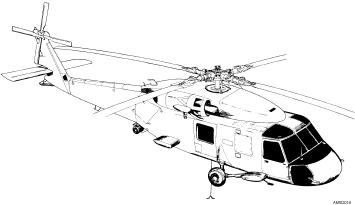
H-60, is shown in figure 2-16. The fuselage consists of
nose gear to the catapult shuttle and for holdback. In
the entire airframe, sometimes known as the body
comparison with the bridle and holdback pendant
group. The body group is of all-metal semimonocoque
method of catapult hookup for launching, the nose gear
construction, consisting of an aluminum and titanium
launch equipment requires fewer personnel, the hookup
skin over a reinforced aluminum frame.
is accomplished more safely, and time is saved in
positioning an aircraft for launch.
Landing Gear Group
ROTARY-WING AIRCRAFT
The landing gear group includes all the equipment
necessary to support the helicopter when it is not in
The history of rotary-wing development embraces
flight. Conventional landing gear consists of a main
500-year-old efforts to produce a workable
landing gear and a nonretractable tail landing gear. See
direct-lift-type flying machine. Aircraft designers'
figure 2-16.
early experiments in the helicopter field were fruitless.
It is only within the last 30 years that encouraging
Main Landing Gear
progress has been made. It is within the past 20 years
that production line helicopters have become a reality.
The main landing gear system consists of
Today, helicopters are found throughout the world.
nonretractable left and right single-wheel landing gear
They perform countless tasks especially suited to their
assemblies and the weight-on-wheels system. Each
unique capabilities. Helicopters are the modern-day
main landing gear assembly is composed of a shock
version of the dream envisioned centuries ago by
strut, drag beam, axle, wheel, tire, and wheel brake. The
Leonardo da Vinci.
left main landing gear assembly also includes a
Early in the development of rotary-wing aircraft, a
weight-on-wheels sensing switch.
need arose for a new word to designate this direct-lift
The main landing gear supports the helicopter
flying device. A resourceful Frenchman chose the two
when on the ground, and cushions the helicopter from
words--heliko, which means screw or spiral, and
shock while landing. The weight-on-wheels switch
pteron, which means wing. The word helicopter is the
provides helicopter ground/flight status indications for
combination of these two words.
various helicopter systems.
A helicopter employs one or more power-driven
horizontal airscrews, or rotors, from which it derives
Tail Landing Gear
lift and propulsion. If a single rotor is used, it is
necessary to employ a means to counteract torque. If
The tail landing gear system consists of a
more than one rotor is used, torque is eliminated by
dual-wheel landing gear, tail wheel lock system, and
turning the rotors in opposite directions.
tail bumper. The tail landing gear is a cantilever type
with an integral shock strut. The gear is capable of
The fundamental advantage the helicopter has over
swiveling 360. It can be locked in trail position by the
conventional aircraft is that lift and control are
tail wheel locking system. A tail recovery assist, secure,
independent of forward speed. A helicopter can fly
and traverse (RAST) probe is mounted on the tail gear.
forward, backward, or sideways, or it can remain in
stationary flight (hover) above the ground. No runway
is required for a helicopter to take off or land. The roof
of an office building is an adequate landing area. The
helicopter is considered a safe aircraft because the
takeoff and landing speed is zero.
The construction of helicopters is similar to the
construction of fixed-wing aircraft.
Fuselage
Like the fuselage in fixed-wing aircraft, helicopter
fuselages may be welded truss or some form of
monocoque construction. Many Navy helicopters are of
the monocoque design. A typical Navy helicopter, the
Figure 2-16.--H-60 helicopter.
2-15

